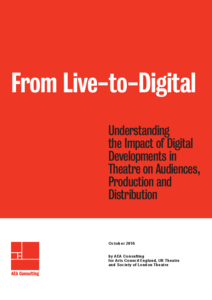
The liveness of theatre, music and dance is an inalienable element of human life. For centuries these performing arts have been experienced by people in the same space and at the same time as the creative process happens, and the desire by audiences for this sort of immediate connection with artists in the act of performance continues unchanged. But more than a century ago technology intervened. The invention of revolutionary methods for sound reproduction led to continually evolving means of capturing and redistrib- uting music, to the point where we have become accustomed to listening to music through channels far removed from the original performance. Yet even here, there remains a demand by music-lovers to hear music of all types in the actual presence of the musicians – an experience that can never be replaced, no matter how perfect the reproduced sound might be.
For theatre, opera and dance the impact of technology has been much more recent. Although capturing live performance on film or for television has been around for many years, it is barely a decade since the first moves were made by the National Theatre in the UK and Metropolitan Opera in the US and towards digital transmission of live performances to locations a long way from the theatre. Since those early days the amount of Live-to-Digital activity across the performing arts has expanded enormously in volume and range. The ra- pidity of this growth has raised some serious questions: In what ways are arts organisations, distributors, funding agencies and consumers reacting to these developments? How are audiences responding to the availability of new chan- nels for consuming traditional products? How do these trends impact upon the need to protect the artistic and cultural integrity of live performance? Is expanded consumption of digital product being achieved at the expense of live attendance at traditional performing arts venues? What is driving the digital market: is it growth in supply, or is it that the availability of new media for the distribution and reception of product is stimulating a latent demand?
A great deal of anecdotal evidence on various aspects of these questions has accumulated in recent times. But, while frequently interesting, the impression it creates may be misleading, and is no substitute for systematic and objective research. So the purpose of this study has been to replace anecdote with hard data. The study is based primarily on theatre in England. Nevertheless, the report contains information and draws conclusions relevant across art-form boundaries, and national jurisdictions. The project applies carefully controlled research methods to derive a wide range of objective and replicable data that provide an extensive overview of the main components of the supply chain for Live-to-Digital product. The conclusions derived from the findings of the research point to both opportunities and challenges in the theatre sector and beyond as the digital environment continues to evolve.
Source: Foreward
